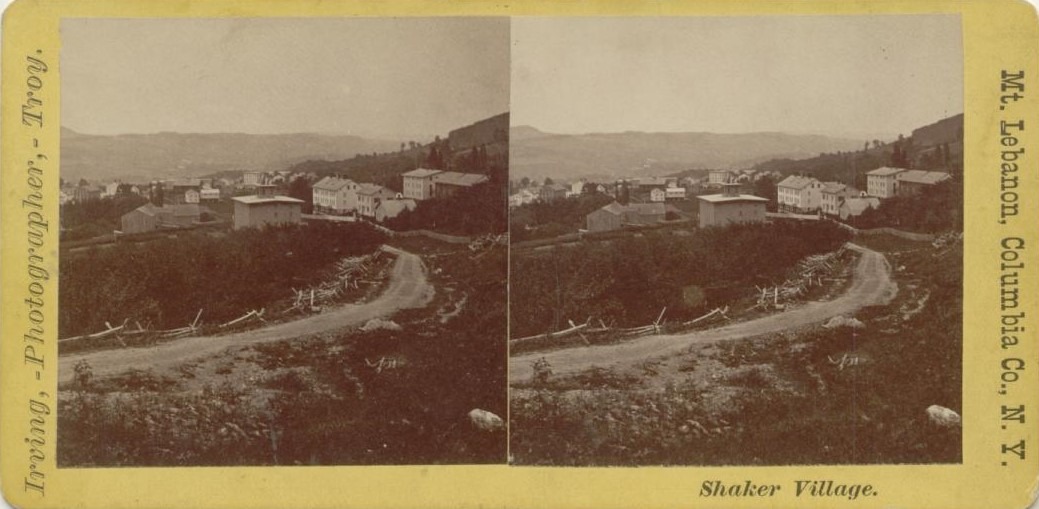
Stereoview (ca. 1880) looking north. South Family is seen in the foreground.
The Shakers – A Visit to Their Establishment
by Henriette Lucie Dillon La Tour du Pin Gouvernet (b. 1770 – d. 1853)
A nice wagon, loaded with fine vegetables, often passed before our door. It belonged to the Shakers, who were located at a distance of six or seven miles. The driver of the wagon always stopped at our house, and I never failed to talk with him about their manner of life, their customs, and their belief. He urged us to visit their establishment and we decided to go there some day….
Those of whom I speak were then protected on all sides by a forest several miles deep. They therefore had no reason as yet to fear their neighbors. Their establishment was bounded on one side by woods which covered 20,000 acres, belonging to the city of Albany, and on the other by the river Mohawk…. This establishment was a branch of their headquarters at Lebanon, which was located in the large forest through which we passed in going from Boston to Albany.
Our negro, Prime, who knew all the routes in our neighborhood, conducted us to their place. At the start we were at least three hours in the woods, following a road which was hardly laid out. Then after having passed the barrier which marked the limits of the Shaker property, the road became more distinct and better marked. But we still had to pass through a very thick forest, broken here and there by fields where cows and horses were pastured at liberty. Finally, we came out in a vast clearing traversed by a pretty stream and surrounded on all sides by woods. In the midst was erected the establishment, composed of a large number of nice wooden houses, a church, schools, and a community house of brick.
The Shaker, whose acquaintance we had made, greeted us with kindness, although with a certain reserve. They showed Prime the stable in which he could put up his horses, for there was no inn. We had been advised that nobody would offer us anything, and that our guide would be the only one to speak to us. He first led us to a superb kitchen-garden perfectly cultivated. Everything was in a state of the greatest prosperity, but without the least evidence of elegance. Many men and women were working at the cultivation or the weeding of the garden. The sale of vegetables represented the principal source of revenue to the community.
We visited the schools for the boys and girls, the immense community stables, the dairies, and the factories in which they produced the butter and cheese. Everywhere we remarked upon the order and the absolute silence. The children, boys and girls alike, were clothed in a costume of the same form and the same color. The women of all ages wore the same kind of garments of gray wool, well kept and very neat. Through the windows we could see the looms of the weavers, and the pieces of cloth which they were dyeing, also the workshops of the tailors and the dress-makers. But not a word or a song was to be heard anywhere.
Finally, a bell rang. Our guide told us that this announced the hour of prayer and asked if we would like to be present. We consented very willingly….
When the Shaker who came to sell vegetables and fruits passed before our farm, I always bought something. He was never willing to take money from my hand. If I remarked that the price which he asked was too high, he replied: “Just as you please.” Then I placed upon the corner of the table the sum which I thought sufficient. If the price was satisfactory, he took it; if not, he climbed into his wagon, without saying a word. He was a man of very respectable appearance, always perfectly dressed in a coat, vest and trousers of gray homespun cloth of their own manufacture.
Published in: Henriette Lucie Dillon La Tour du Pin Gouvernet, Recollections of the Revolution and the Empire From the French of the “Journal D’une Femme de Cinquante Ans”. Written about 1843, first published 1906, edited and translated by Walter Geer (New York: Brentano’s, 1920), p. 214 ff. Her visit to the Shakers, described above, took place in 1795. A digital edition of this book is available on line.

